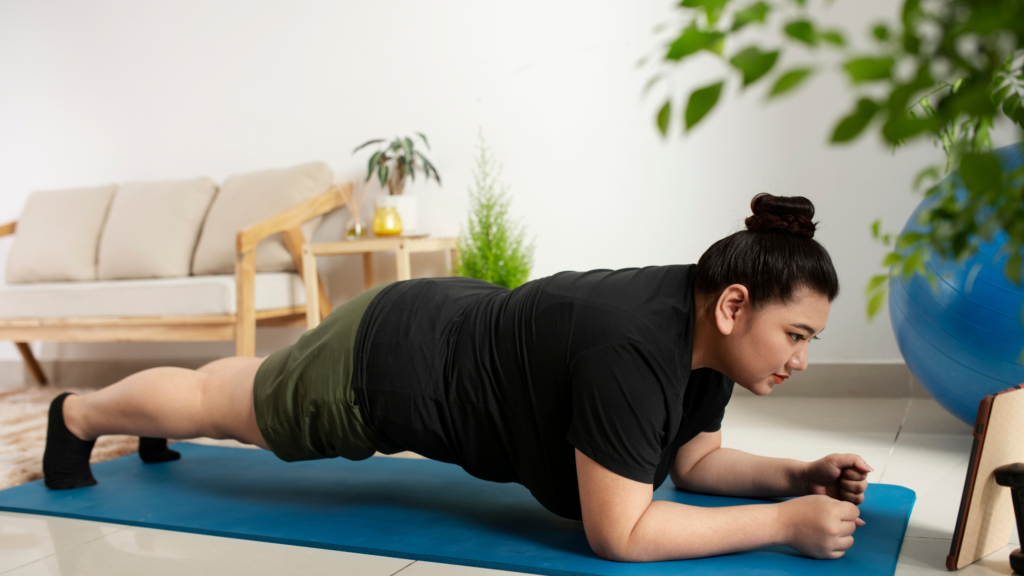How to Lose Belly Fat

2. Managing Post-Hysterectomy Pain and Discomfort
- Pain Medication: Your healthcare provider may prescribe pain medication to relieve stomach pain. It is important to follow your doctor’s instructions regarding dosage and frequency.
- Ice Packs: Applying an ice pack to the surgical site can help reduce swelling and numb the area, which can provide temporary relief from pain.
- Gentle Movement: Although it is important to rest and avoid strenuous activity, light movement such as a short walk can promote blood circulation and prevent stiffness in the abdominal muscles.
Back Pain:
- Proper Posture: Maintaining good posture is crucial for preventing and alleviating back pain. Use supportive pillows when sitting or lying down to provide adequate lumbar support.
- Light Stretching: Engage in gentle stretching exercises to relieve tension in the back muscles. Avoid overexertion and listen to your body’s signals.
- Physical Therapy: Your healthcare provider may recommend physical therapy sessions to target specific areas of back pain and improve overall mobility.
Vaginal Discomfort:
- Avoiding Heavy Lifting: Refrain from lifting heavy objects or engaging in activities that put pressure on the pelvic area to minimize vaginal discomfort.
- Pelvic Floor Exercises: Practicing Kegel exercises can strengthen the pelvic floor muscles and alleviate vaginal discomfort. Consult with a healthcare provider for guidance on proper technique.
- Topical Treatments: Over-the-counter topical creams or ointments may provide relief from vaginal discomfort. Ensure that any products used are approved by your healthcare provider.
3. Effective Exercise Regimens for Belly Fat Reduction After Hysterectomy
Practice of a proper fitness program on regular basis is vital for the reduction of belly fat and therefore for realizing a good health after a hysterectomy. On the other side of the medallion, it is vital to watch out for exercise and adjust it to work with the body demands during the healing cycles. How to lose belly fat after a hysterectomy.
1. Low-Impact Cardiovascular Exercises:
- Walking: Walking is a low-impact cardiovascular exercise that can easily be incorporated into your daily routine. Start with short walks and gradually increase the duration as you build strength and endurance.
- Swimming: Swimming provides a full-body workout without putting excessive strain on the joints. It’s an excellent option for individuals looking to improve cardiovascular health and burn calories without aggravating post-hysterectomy discomfort.
- Cycling: Stationary cycling or outdoor biking is another low-impact cardiovascular exercise that helps strengthen the lower body muscles and improve overall fitness levels.
2. Core-Strengthening Exercises:
- Planks: Planks are an effective core-strengthening exercise that targets the abdominal muscles, including the transverse abdominis and rectus abdominis. Start with short intervals and gradually increase the duration as your core strength improves.
- Pelvic Tilts: Pelvic tilts help strengthen the pelvic floor muscles and improve core stability. Lie on your back with your knees bent, then gently tilt your pelvis upwards while engaging your abdominal muscles. Hold for a few seconds before releasing.
- Bridge Exercises: Pulls target the glutes, hamstrings, and lower back muscles while also engaging the core. Lie on your back with your knees bent and feet flat on the floor, then lift your hips off the ground while squeezing your glutes. Hold for a few seconds before lowering back down.
4. Optimizing Sitting Positions for Comfort and Healing
Having a comfortable sitting position might be very important for your overall comfort and healing after a hysterectomy. How to lose belly fat after a hysterectomy. Here are some pointers for post-hysterectomy sitting position optimization:

1. Maintain Proper Posture:
- Sit Up Straight: Avoid slouching or leaning forward when sitting, as this can put extra stress on your abdominal muscles and spine. Keep your shoulders back, chest up, and spine aligned in a neutral position to minimize pressure on your surgical site.
- Distribute Weight Evenly: Distribute your body weight evenly across both hips while sitting to prevent asymmetrical loading and reduce the risk of developing pressure points or discomfort.
2. Take Frequent Breaks:
- Move and Stretch: Take regular breaks from sitting to stand, stretch and move around periodically. Gentle stretching exercises can help reduce muscle tension and improve circulation throughout your body.
- Change Positions: Alternate between sitting, standing, and lying down throughout the day to avoid prolonged periods of sitting in one position.
4. Avoid Cross-Legged Sitting:
- Cross-Legged Position: Avoid sitting with your legs crossed, as this can restrict blood flow to your lower back and increase pressure on your pelvic area. Instead, keep both feet flat on the floor and bend the knees at a comfortable angle to improve circulation and posture.
5. Listen to Your Body:
- Pay Attention to Discomfort: If you feel any discomfort or pain while sitting, listen to your body’s cues and adjust your position accordingly. Experiment with different sitting positions, cushions, or supports until you find what works best for you.
- Take Rest Breaks: If you are feeling tired or sore, prioritize rest and relaxation and lie down for a while in a comfortable position. Give your body time to recover and rejuvenate before resuming activities that require prolonged sitting.
5. Restoring Sexual Comfort and Satisfaction After Hysterectomy
Sexual comfort and satisfaction can be impacted by a hysterectomy, but with patience, communication, and understanding, it’s possible to restore intimacy and enjoyment in your sexual relationship. Here are some tips for navigating this aspect of post-hysterectomy recovery:
1. Explore Alternative Intimacy:
- Embrace Non-Sexual Touch: Engage in affectionate gestures such as hugging, kissing, and holding hands to maintain closeness and connection with your partner. Focus on non-sexual forms of physical affection that feel comfortable and pleasurable for both of you.
- Experiment with Sensual Activities: Explore sexual activities such as massage, touching, or bathing together to increase intimacy and pleasure without the pressure of sex.
2. Address Physical Changes:
- Manage Pain and Discomfort: Take steps to relieve any physical discomfort or pain that occurs during sexual activity. This may include using lubricants to reduce friction, trying different positions to reduce pressure on sensitive areas, or taking pain medication as prescribed by your healthcare provider.
- Address Vaginal Dryness: Hormonal changes after a hysterectomy can lead to vaginal dryness, which can affect sexual comfort and pleasure. Use water-based lubricants or moisturizers to relieve dryness and increase lubrication during intercourse.
4. Experiment with Sexual Positions:
- Find Comfortable Positions: Experiment to find different sex positions that feel comfortable and pleasurable for both you and your partner. Focus on positions that minimize pressure on your abdominal area and allow for deep penetration without discomfort.
- Use Pillows or Supportive Cushions: Add pillows or support cushions to provide extra comfort and support during sexual activity. Experiment with different arrangements to find the best positioning for your body.
6. Addressing Back Pain and Discomfort Following Hysterectomy
Back pain and discomfort are common issues that many individuals experience after undergoing a hysterectomy. These symptoms can arise due to various factors, including changes in posture, muscle weakness, and surgical trauma. How to lose belly fat after a hysterectomy. Here are some strategies to help manage back pain after hysterectomy:
1. Gentle Movement and Stretching:
- Low-Impact Exercises: Engage in low-impact exercises such as walking, swimming, or gentle yoga to improve flexibility and strengthen the muscles that support your spine.
- Daily Stretching Routine: Incorporate daily stretching exercises to reduce tension in your back muscles and improve range of motion. Focus on stretches that target the lower back, glutes, and hamstring muscles, such as cat-cow, child’s pose, and seated forward bends.
2. Proper Posture and Body Mechanics:
- Maintain Neutral Spine Alignment: Practice proper posture by keeping your spine in neutral alignment while sitting, standing, and walking. Avoid bending or arching your back excessively, as this can cause muscle strain and back pain.
- Use Proper Lifting Techniques: When lifting objects, bend your knees and use your leg muscles to lift instead of bending from the back. Hold the object close to your body and avoid twisting or jerking movements that can strain your back muscles.
4. Heat and Cold Therapy:
- Apply Heat: Use heat therapy, such as a heating pad or hot towel, to relax tense muscles and reduce back pain. Apply heat to the affected area for 15-20 minutes at a time several times a day as needed.
- Use Cold Packs: Cold therapy can help numb the area to reduce inflammation and provide temporary relief from back pain. Apply a cold pack or ice pack wrapped in a towel to the affected area for 10-15 minutes at a time, several times a day.
1. Surgical Incision Healing:
- Inspect Incision Sites: Inspect incision sites regularly for any signs of infection, such as redness, swelling, warmth, or drainage. Monitor the healing process and report any abnormalities to your healthcare provider.
- Follow Wound Care Instructions: Follow your healthcare provider’s instructions for wound care, including keeping the incision sites clean and dry, changing dressings as needed, and avoiding activities that may put strain on the incisions.
1. Rest and Relaxation:
- Allow Ample Rest: Listen to your body’s signals and prioritize adequate rest and sleep during the recovery period. Aim for 7-9 hours of quality sleep each night and take short naps during the day as needed to support healing and rejuvenation.
- Practice Relaxation Techniques: Incorporate relaxation techniques such as deep breathing, meditation, guided imagery, or progressive muscle relaxation into your daily routine to help reduce stress and promote relaxation.
1. Healthy Diet and Nutrition:
- Eat a Balanced Diet: Continue to prioritize a balanced diet rich in fruits, vegetables, whole grains, lean proteins, and healthy fats. Aim to consume a variety of nutrient-dense foods to provide your body with essential vitamins, minerals, and antioxidants.
- Limit Processed Foods: Minimize consumption of processed foods, sugary snacks, and high-fat meals, which can contribute to weight gain, inflammation, and other health issues. Instead, opt for whole, unprocessed foods whenever possible.
2. Regular Physical Activity:
- Engage in Regular Exercise: Incorporate regular physical activity into your daily routine to support cardiovascular health. Aim for at least 150 minutes of moderate-intensity aerobic activity or 75 minutes of vigorous-intensity activity per week, as recommended by health guidelines.
- Include Strength Training: Incorporate strength training exercises into your fitness routine to build and maintain muscle mass, improve bone density, and support overall physical function. Use resistance bands, free weights, or body weight exercises to target major muscle groups.
3. Stress Management and Mental Health:
- Prioritize Mental Health: Take care of your mental and emotional well-being by seeking support from friends, family members, or mental health professionals as needed. Practice self-care activities that bring you joy and fulfillment, such as hobbies, creative pursuits, or spending time in nature.












Your article helped me a lot, is there any more related content? Thanks!
I don’t think the title of your article matches the content lol. Just kidding, mainly because I had some doubts after reading the article.